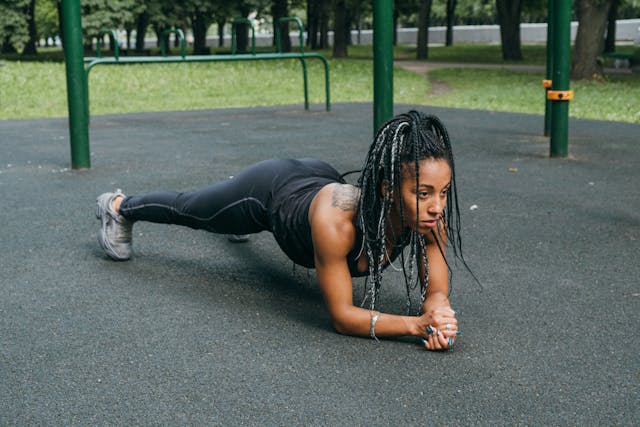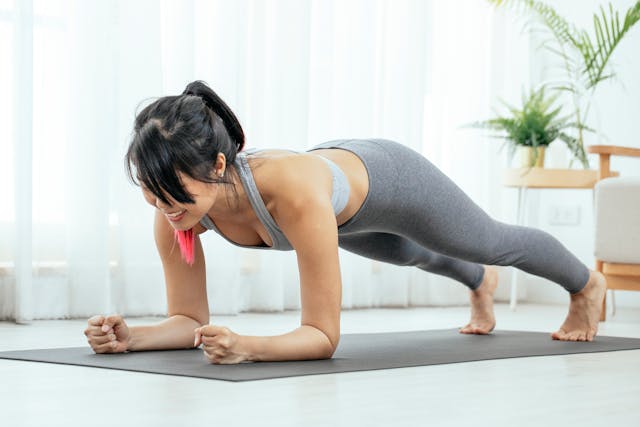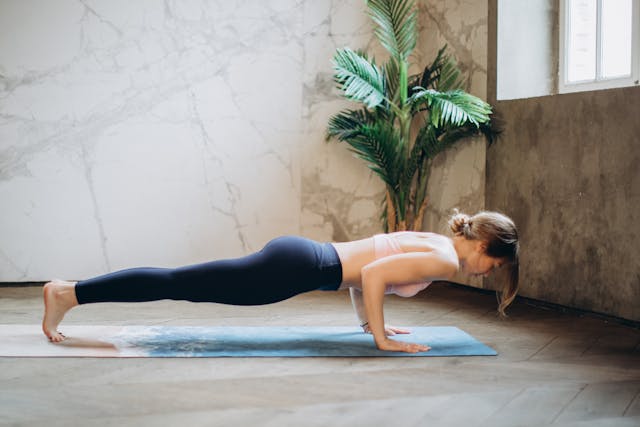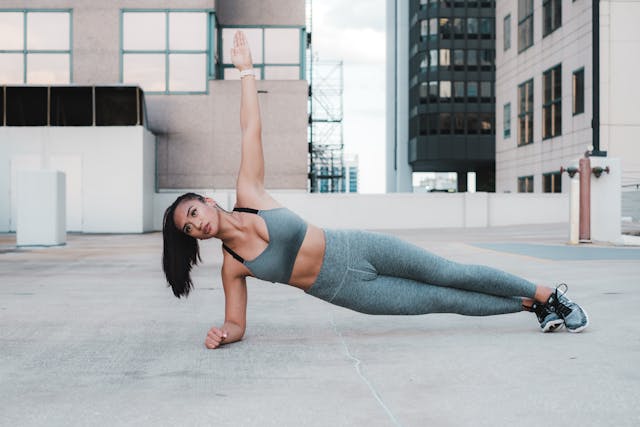In this article, we explore how to do a plank (including common mistakes and different variations).
Table of Content:
Plank
The plank is one of the most effective exercises for building core strength and stability. It’s a simple, yet challenging movement that engages multiple muscle groups at once, including your abs, back, shoulders, and legs. What makes the plank so popular is its accessibility. Anyone, from beginners to advanced fitness enthusiasts, can perform this exercise with little to no equipment. Despite its simplicity, maintaining proper form during a plank is crucial to avoid injury and get the most out of the exercise. In this guide, we’ll cover how to do a plank correctly, common mistakes to avoid, and some variations to try as you progress.
What is a Plank?
At its core, the plank is an isometric exercise, meaning it involves holding a static position for a set amount of time without moving. It primarily targets the muscles in your core, including the rectus abdominis (the “six-pack” muscles), transverse abdominis (deep core muscles), obliques (side ab muscles), and the muscles in your lower back. However, the plank also engages your shoulders, chest, legs, and glutes, making it a full-body workout that builds both strength and endurance.

Benefits of Plank
- Core Strength: The plank is one of the best exercises for strengthening your entire core, which helps support better posture and protects your lower back from injury.
- Improved Stability: By engaging various muscle groups, the plank helps improve overall stability and balance.
- Full-Body Engagement: Although it focuses on the core, the plank activates muscles in the arms, shoulders, legs, and glutes, making it a compound movement that works multiple areas of the body at once.
- No Equipment Required: You can do planks anywhere, as they require no weights or machines—just your body weight.
- Posture Correction: A strong core helps maintain good posture, which is crucial for everyday activities, whether you’re sitting at a desk or lifting heavy objects.

How to Perform a Proper Plank Exercise
1. Start in a Prone Position
Begin by lying face-down on the floor or on a mat. This will be your starting position.
2. Position Your Hands and Arms
- For the forearm plank, place your forearms on the ground with your elbows directly under your shoulders, forming a 90-degree angle at the elbows. Your forearms should be parallel, and your hands can either be flat on the ground or clasped together.
- For the straight-arm plank (also called the high plank), place your hands on the ground shoulder-width apart, as if you’re in the top position of a push-up.
3. Extend Your Legs
Straighten your legs behind you, and place your toes on the ground. Your feet should be hip-width apart or closer together, depending on what feels comfortable for you. Make sure your legs are straight and engaged, with your knees lifted off the ground.
4. Engage Your Core
This is one of the most important aspects of the plank. Tighten your abdominal muscles by pulling your belly button towards your spine. This bracing of the core helps stabilize your body and prevents your lower back from sagging.
5. Align Your Body
Ensure that your body forms a straight line from your head to your heels. Your hips should not be sagging toward the floor or lifted too high. A straight alignment means your shoulders, hips, and heels are all in one line.
- Keep your head neutral, looking slightly ahead of your hands, not up or down.
- Squeeze your glutes and engage your thighs to maintain this straight posture.
6. Hold the Position
Hold this position for as long as you can while maintaining proper form. If you’re new to planks, aim to start with 20–30 seconds and work your way up to holding the plank for longer durations (up to 1–2 minutes).
Common Mistakes to Avoid
While the plank might seem like a simple exercise, it’s easy to make mistakes that reduce its effectiveness or put unnecessary strain on your body. Let’s look at some common errors and how to correct them.
1. Sagging Hips
One of the most frequent mistakes is allowing the hips to drop toward the floor. This causes the lower back to arch, putting stress on the spine and taking the focus away from the core muscles. Correction: Engage your core and glutes to keep your hips in line with your shoulders and heels.
2. Lifting Hips Too High
On the opposite end, some people raise their hips too high, forming more of a triangle shape than a straight line. This shifts the focus away from the core and onto the shoulders. Correction: Keep your body in a straight line by tightening your core and glutes.
3. Looking Up or Down
Straining your neck by looking too far up or down can lead to discomfort. Correction: Keep your head in a neutral position, looking slightly in front of your hands.
4. Holding Your Breath
It’s common to forget to breathe during planks, but holding your breath can make the exercise more difficult. Correction: Focus on taking slow, deep breaths while holding the plank.

How Long Should You Hold a Plank?
The duration of a plank depends on your fitness level. For beginners, holding a plank for 20–30 seconds is a good starting point. As your strength improves, aim to increase this time gradually, working up to 1–2 minutes or more. The key is to focus on maintaining proper form for the entire duration, rather than holding the position for a long time with poor posture.
If you feel your form deteriorating, it’s better to rest and try again later, rather than continuing with bad technique.
Plank Variations to Try
Once you’ve mastered the basic plank, you can challenge yourself with these variations to engage different muscle groups and increase the difficulty.

1. Side Plank
This variation targets your obliques. To perform a side plank, rotate onto one forearm or hand, stack your feet, and lift your hips to create a straight line from head to heels. Keep your core engaged to avoid sagging.
2. Plank with Arm or Leg Lift
Adding an arm or leg lift challenges your balance and stability. From the basic plank position, lift one arm or leg off the ground while maintaining the plank posture. Alternate arms or legs for an added challenge.
3. Plank to Push-up
This dynamic variation involves moving between a forearm plank and a straight-arm plank. Start in a forearm plank, then press up into a straight-arm plank, alternating between the two positions.
The Bottom Line
The plank is a versatile and highly effective exercise for building core strength, improving stability, and enhancing overall fitness. With proper form, it engages not just the abs but also the shoulders, back, legs, and glutes. Whether you’re a beginner or advanced, incorporating planks into your workout routine can help strengthen your core, improve posture, and reduce the risk of injury in other exercises or daily activities. By mastering the basic plank and progressing to variations, you’ll be well on your way to a stronger, more stable body. It can also be incorporated within our ALPHA 2 Months Challenge.


